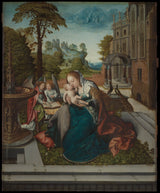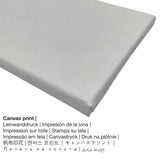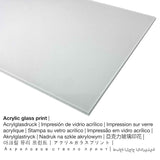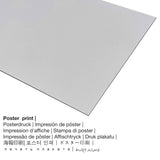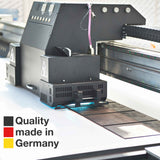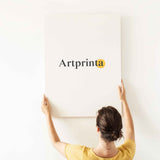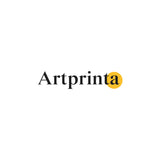Bernard van Orley, 1518 - Nwa agbọghọ na-amaghị nwoke na nwatakịrị nwere ndị mmụọ ozi - mbipụta nka mara mma
Ụtụ gụnyere. Mbupu gbakọrọ na ndenye ọpụpụ.
Ọ bụ onye na-ese ihe sere ihe osise ahụ Bernard van Orley n’afọ 1518. Ihe kariri 500 years old original was made with the following size: 33 5/8 x 27 1/2 in (85,4 x 69,9 cm). Mmanụ na osisi was used by the Dutch painter as the technique for the artwork. Today, this artwork can be viewed in in the Ụlọ ihe ngosi nka nke Metropolitan nchịkọta dijitalụ dị na New York City, New York, Njikota Obodo Amerika. This public domain piece of art is included with courtesy of The Metropolitan Museum of Art, New York, Bequest of Benjamin Altman, 1913. Moreover, the artwork has the creditline: Bequest of Benjamin Altman, 1913. The alignment is Eserese ma nwee akụkụ nke 1: 1.2, nke pụtara na ogologo bụ 20% mkpụmkpụ karịa obosara.
Original artwork information as provided from the museum (© Copyright - The Metropolitan Museum of Art - Museumlọ ihe ngosi nka nke Obodo)
Van Orley probably painted this refined and intimate picture of the Virgin and Child about the time of his appointment in 1518 as official painter to Margaret of Austria, regent of the Netherlands. A courtly Madonna of Humility, the Virgin wears a luxurious fur-trimmed dress and is seated on the ground in the enclosed but spacious garden of her palace. She is accompanied by two singing angels, who are echoed by grisaille angels in heaven. The distant background testifies to the painter’s awareness of the developing landscape genre, and the elaborately ornamented fountain incorporates Italian Renaissance decorative motifs.
Nkọwa ọrụ nka
| Aha nke eserese ahụ: | "Nwa agbọghọ na nwa na ndị mmụọ ozi" |
| nhazi ọkwa: | sere |
| Category: | nka ochie |
| Century: | 16th narị afọ |
| Ekepụtara: | 1518 |
| Afọ nka: | karịa afọ 500 |
| Ihe osise izizi: | mmanụ n'elu osisi |
| Nha izizi: | 33 5/8 x 27 1/2 na (85,4 x 69,9 cm) |
| Ụlọ ihe ngosi nka / mkpokọta: | Museumlọ ihe ngosi nka nke Obodo |
| Ebe ebe ngosi nka: | New York City, New York, Njikota Obodo Amerika |
| Weebụsaịtị ihe ngosi nka: | www.metmuseum.org |
| Ụdị nka nka: | ngalaba ọha |
| Site n'aka: | Ụlọ ihe ngosi nka nke Metropolitan, New York, Arịrịọ nke Benjamin Altman, 1913 |
| kreditline ọrụ nka: | Arịrịọ nke Benjamin Altman, 1913 |
Banyere omenka
| Aha onye nka: | Bernard van Orley |
| okike nke onye nka: | nwoke |
| Obodo onye nka: | Dutch |
| Ọrụ nke onye na-ese ihe: | onye na-ese ihe |
| Country: | mba netherland |
| nhazi ọkwa: | nna ukwu ochie |
| Ndụ: | 50 afọ |
| A mụrụ: | 1492 |
| Nwụrụ n'afọ: | 1542 |
Nweta ụdị ebipụta nka ị chọrọ
Anyị na-enye ụdị dị iche iche nha na ihe maka ngwaahịa ọ bụla. Nha na ihe ndị a bụ nhọrọ anyị na-enye gị maka nkeonwe:
- Aluminom dibond mbipụta (ọla): An Aluminium Dibond print is a material with an outstanding depth effect. The non-reflective surface creates a modern impression. The Direct Print on Aluminum Dibond is your perfect start to art replicas with aluminum. For your Aluminium Dibond print, we print the artpiece on the aluminium white-primed surface.
- Akwụkwọ mmado na ihe kwaaji: Our poster is a UV printed sheet of flat canvas with a slightly rough texture on the surface. The poster print is optimally used for placing your art copy in a custom-made frame. Please bear in mind, that depending on the size of the canvas poster print we add a white margin of something between 2-6cm round about the print, which facilitates the framing with your custom frame.
- Mbipụta kwaaji: A printed canvas, which shall not be mistaken with an artwork painted on a canvas, is a digital copy printed on a UV direct printer. It creates a plastic look of three-dimensionality. The advantage of canvas prints is that they are relatively low in weight, which implies that it is quite simple to hang the Canvas print without additional wall-mounts. Therefore, a canvas print is suitable for all kinds of walls.
- Ihe odide acrylic glass: The print on acrylic glass, often named a UV print on plexiglass, changes your favorite artwork into beautiful décor. In addition to that, it forms a viable alternative option to canvas or dibond prints. Your own replica of the work of art is custom-made thanks to the help of state-of-the-art UV printing machines. With an acrylic glass art print contrasts plus color details will be more visible thanks to the delicate gradation of the picture.
Nkọwa ihe ahaziri ahazi
| Bipụta ụdị ngwaahịa: | nka nka |
| Usoro mmeputakwa: | dijitalụ mmeputakwa |
| Usoro mmepụta: | Mbipụta UV ozugbo |
| Mmalite ngwaahịa: | German mmepụta |
| Stockdị ngwaahịa: | a na-achọ |
| Eji ngwaahịa emebere: | mgbidi mma, art ebipụta gallery |
| Nhazi nka nka: | usoro eserese |
| Oke akụkụ onyonyo: | 1: 1.2 ogologo ruo obosara |
| Nkọwa nke oke onyonyo a: | ogologo bụ 20% mkpụmkpụ karịa obosara |
| Akụrụngwa ị nwere ike ịhọrọ: | Mpempe akwụkwọ, akwụkwọ mmado (akwụkwọ kwaaji), mbipụta ọla (aluminium dibond), mbipụta iko acrylic (nwere ezigbo mkpuchi iko) |
| Mpempe akwa akwa (akwa akwa na etiti ihe ndọtị) nha: | 50x60cm - 20x24", 100x120cm - 39x47", 150x180cm - 59x71" |
| Mbipụta iko acrylic (nwere ezigbo mkpuchi iko) dị iche iche: | 50x60cm - 20x24", 100x120cm - 39x47" |
| Mpempe akwụkwọ mmado (akwụkwọ kwaaji) nha dị iche iche: | 50x60cm - 20x24", 100x120cm - 39x47" |
| Nha ebipụta aluminom: | 50x60cm - 20x24", 100x120cm - 39x47" |
| Nhazi nke nka nka: | adịghị |
Disclaimer: We try whatever we can to depict our products in as much detail as possible and to demonstrate them visually in our shop. However, the tone of the print products, as well as the printing can diverge somehwat from the presentation on your screen. Depending on the screen settings and the condition of the surface, color pigments might not be printed as realistically as the digital version. Since our fine art prints are printed and processed manually, there might as well be slight differences in the motif's size and exact position.
© Copyright - ikike ọgụgụ isi nke | www.artprinta.com (Artprinta)

